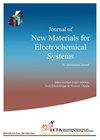皮秒脉冲电场(PPEF)的潜在应用:潜在的COVID-19治疗的先进生物电技术
IF 0.6
4区 材料科学
Q4 ELECTROCHEMISTRY
Journal of New Materials For Electrochemical Systems
Pub Date : 2021-12-31
DOI:10.14447/jnmes.v24i4.a10
引用次数: 3
摘要
随着人类知识的增长,解决临床问题的工具的有效性和准确性也有所提高。COVID-19的挑战对人类生命构成了重大威胁,反映出需要升级现有技术并使治疗更加精确。由于冠状病毒颗粒在纳米范围内,显然需要一种精度超过纳米范围的设备来控制和消除它。皮秒脉冲电场(PPEF)是一种很好的抗病毒皮技术候选。PPEF能量可以(1)增强多形核中性粒细胞的先天免疫功能,(2)破坏细菌和其他病原体,(3)潜在地灭活病毒颗粒。ppe的这一特性已经在食品工业中得到了应用。PPEF和纳秒PEF技术都被用于治疗研究动物的癌症,并已达到临床前和临床人体试验阶段,很快将用于临床实践。应用先进的PPEF技术对抗COVID-19将为有效的人类抗病毒治疗提供新的机会。本文章由计算机程序翻译,如有差异,请以英文原文为准。
Potential Application of Picosecond Pulsed Electric Field (PPEF): Advanced Bioelectrical Technology for Potential COVID-19 Treatment
As human knowledge has increased, the efficacy and precision of tools to solve clinical problems have also increased. The challenge of COVID-19 has posed a significant threat to human life and reflects the need to upgrade existing technologies and make treatments more precise. Since the corona virus particle is in the nanometer range, the need for a device with accuracy beyond the nanometer range is apparent to control and eliminate it. Using Picosecond Pulsed Electric Fields (PPEF) could be a good antiviral picotechnology candidate. PPEF energy can (1) increase the innate immunity function of polymorphonuclear neutrophils, (2) destroy bacteria and other pathogens, and (3) potentially inactivate viral particles. This characteristic of PPEFs has already been used in the food industry. Both PPEF and nanosecond PEF technology is being used to treat cancer in research animals and has reached the stage of pre-clinical and clinical human trials with use in clinical practice soon to follow. Applying advanced PPEF technology against COVID-19 should provide new opportunities for effective human antiviral treatment. .
求助全文
通过发布文献求助,成功后即可免费获取论文全文。
去求助
来源期刊

Journal of New Materials For Electrochemical Systems
ELECTROCHEMISTRY-MATERIALS SCIENCE, MULTIDISCIPLINARY
CiteScore
1.90
自引率
0.00%
发文量
33
审稿时长
>12 weeks
期刊介绍:
This international Journal is intended for the publication of original work, both analytical and experimental, and of reviews and commercial aspects related to the field of New Materials for Electrochemical Systems. The emphasis will be on research both of a fundamental and an applied nature in various aspects of the development of new materials in electrochemical systems.
 求助内容:
求助内容: 应助结果提醒方式:
应助结果提醒方式:


